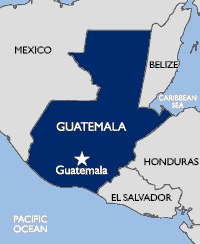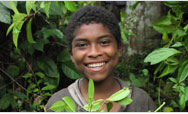Guatemala
USAID is succeeding in preserving the environmentally significant lands of Guatemala primarily through protected area management, training and technical assistance, and vulnerability reduction and adaptation. Simultaneously, these efforts have addressed the issue of climate change by preserving carbon stocks and building the capacity of the Guatemalans to reduce greenhouse gas emissions.
Background

Guatemala is among the world’s top tourism destinations due to its biodiversity, cultural heritage, and historic past. Efforts to preserve this diversity have been recognized and supported by the United Nations Educational, Scientific, and Cultural Organization (UNESCO), the Ramsar Convention on Wetlands, and other international organizations and treaties. Guatemala’s importance as a point of convergence of species migrating from both North and South America is vital for the conservation of many migratory bird species from the United States.
Sector-Specific Climate Change Activities
In recent years, USAID’s environment program in Guatemala has supported environmentally sound management of natural resources in priority areas of great biodiversity, including the Maya Biosphere Reserve in the Petén, the Motagua-Polochic system (which includes the Sierra de las Minas Biosphere Reserve), and the Atitlan Volcanoes Bioregion. USAID’s program also provided assistance to develop sustainable income generation alternatives to people living in and around protected areas. These include efforts to establish carbon credit initiatives, certify timber production, control forest fires, develop non traditional forest products, encourage tourism, and promote environmentally sound production practices. Through the direct and indirect consequences of these initiatives, it is estimated that Guatemala has the potential to sequester over 89 million tons of carbon by 2012.
Addressing Climate Change Through Natural Resources Management and Conservation of Carbon Stocks
USAID support has contributed to a Maya Biosphere Reserve (MBR) carbon project initiative that has brought a half million forested hectares under Forest Stewardship Council (FSC) certification, using a voluntary market through which individuals and entities purchase carbon offsets to reduce greenhouse gas emissions. This initiative demonstrates an important alliance between the Guatemalan public sector and the forestry concessionaries, both to communities and the two industry concessions, located in the Multiple Use Zone of the MBR. These key stakeholders are investing in the development of a carbon baseline, project design documents, certification of the project and approaching potential buyers in international markets. In order to prepare Guatemala for participation in global carbon credit market schemes, USAID completed an analysis of carbon credit potential in various forest ecosystems in 2007. This work will facilitate carbon offsetting investments from wealth country emitters.
In addition to the direct environmental benefits, significant economic gains have already been realized. In fiscal year 2007, 2.6 million board feet of certified and forest products in “process of certification” were sold for $5.1 million. USAID supported the consolidation of business links between certified timber producers and buyers and helped develop incentives for certified forest management and chain of custody tracking. Additionally, USAID helped open important markets for “xate,” a non timber forest foliage product. A total of 14,463 xate bunches were sold for $147,948.
Considering that forests have an economic value and provide key environmental services, it is critical to maintain the forest cover, especially in the MBR, a protected area which contributes to reducing carbon emissions and enhancing the livelihoods of surrounding communities.
Addressing Climate Change Through Sustainable Tourism
Sustainable tourism supports the maintenance of stable populations, conservation of biodiversity, and sustenance of critical wildlife species. USAID supported the Geotourism Initiative that consists of a Geotourism Charter signed by the National Geographic Society (NGS), the Government of Guatemala, and the private sector, to sustain and enhance the environment and the diversity of the cultural, historic and scenic assets of Guatemala. USAID promoted the certification of 30 new Small and Medium Enterprises and community based operations (CBOs) under the Green Deal certification seal and supported the marketing of certified venues. USAID also helped to improve various web portals and the design of fact sheets for 13 tourism destinations. Also in 2007, 1,118 people (including 602 women) received increased economic benefits from sustainable tourism. USAID granted four scholarships to women to participate in a formal community tourism education program. The handicrafts component of this program helped women’s groups to legalize their organizations and also provided technical assistance on new market trends.
This project builds upon past accomplishments; in previous years, USAID has funded projects to install tourist infrastructure, train park staff in municipal parks administration, and help leverage financial resources to build trails, a visitor center, and a geology museum in Atitlan. In San Marcos and San Juan municipalities, park boundaries were mapped and delimited, and best management practices for sustainable land use were developed. All these elements served as inputs to develop natural resource management plans.
Forest Fire Prevention and Control
Reducing forest fires and forest fire threats is a key focus of USAID/ Guatemala’s assistance in the Maya Biosphere Reserve where in 2005, 375,000 hectares (nearly 1/5 of the reserve) burned during the fire season. USAID support has equipped and trained municipal fire brigades in all seven municipalities of the region, and Defensores de La Naturaleza (the organization co-managing the area) is actively engaged in fire prevention establishing fire breaks, conducting prescribed burns, and establishing voluntary brigades to conduct patrols and monitoring activities. In addition, USAID is funding direct fire suppression activities through the provision of training, equipment and transportation, as well as a strong prevention component through public outreach and community patrolling in high risk areas. Approximately 10,000 hectares of high value tropical forest have been protected from destruction, and carbon emissions avoided, due to increased capacity to prevent and suppress human caused wildfire.
Partners
USAID’s partners in climate change activities in Guatemala include:
- Abt Associates
- Counterpart International
- National Geographic Society
- Technoserve
- The Rainforest Alliance
- Wildlife Conservation Society (WCS)
Because partners change as new activities arise, this list of partners is not comprehensive.
Back to Top ^
|


